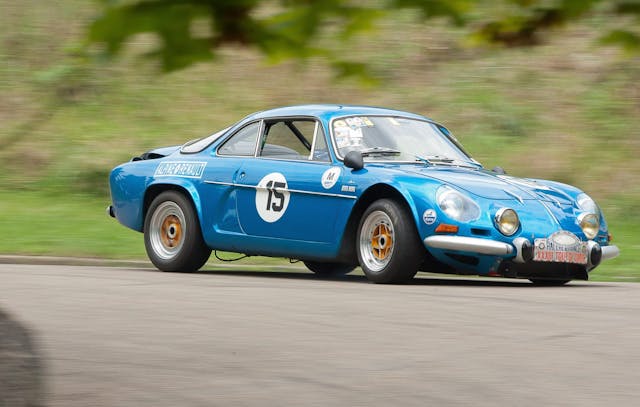A layperson’s guide to getting into vintage racing
Vintage racing is like a fancy slot car set come to life—these are the cars you’d have picked out for your Scalextric track as a kid, and now you get to line up among them. But what does it take to be among that grid? It’s actually not as intimidating as you might think.
With the notable exception of those brilliant scrums you see at Goodwood, vintage racing tends to be an 8/10ths affair—more active than a static car show but not as intense for participants as a SCCA or pro weekend. And you don’t need a Ferrari 250 GTO or vintage Trans Am car to take part. At a regional airport runway near you, vintage homebuilt specials are dodging hay bale barriers—in fact, between now and the end of the year, motorsportreg.com boasts 17 events across the country.
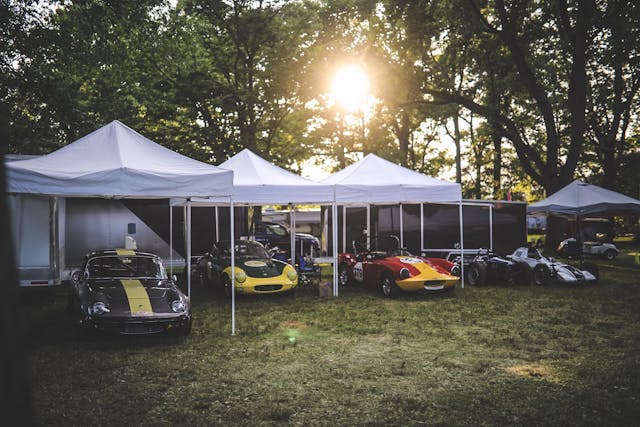
Of course, there is a learning curve. Here’s what you need to consider.
Let’s start with you. You’ll need a license, of course. If you’re already an SCCA racer or hold a racing license with another recognized sanctioning body, this is just a matter of paperwork to get one through the Sportscar Vintage Racing Association. If you’re not there yet, well, get started: attend a recognized driving school.
Now, what are you driving? A lot of people interested in vintage racing have a specific car in mind, but before plonking down cash, take a minute to define your goals. You want to be sure that dream car is up to them.
People hit the track in vintage metal for all sorts of reasons. Do you simply want to turn a wheel as quickly as you’re comfortable in your classic once a year? Or are you aiming to win every event on the vintage racing calendar? Do you want to be in a large field with a wealth of similarly-prepped cars, or are you fine racing in a smaller class? Is frequent wrenching between sessions something you enjoy (or enjoy watching people do for you), or do you want a more reliable car that will run a weekend with minimal effort? Remember, this should be a fun undertaking, and preparation helps set expectations.
You can start answering these questions by engaging folks at the events in which you intend to race. This will reveal local nuances, like car count across run groups (different classes are more or less popular in different regions). Chat up the drivers and mechanics in the paddock—see what they think about running that car, or ask about resources. Most people will be happy to chat. One of the nice things about vintage racing, you’ll find, is the camaraderie and relaxed atmosphere.
Once you’ve picked the kind of car you want, finding the right example—for the right price—takes some consideration. There are fewer guides available than if you were to purchase a classic street car—valuation varies broadly with race cars, particularly for the more workaday former SCCA cars as compared to high-dollar, high-provenance cars. Here are a few basic tips to consider:
- Seek professional help. I’m not talking about a therapist but rather, an appraiser—a trained eye who can suss out issues with the car and determine how period-correct it is (notice I didn’t say original—panels, drivetrains, wheels, everything is a consumable in racing). Reputable race shops that specialize in your desired marque can tell you the condition of the wear items, and what the refresh schedule is likely to be. You’d get a pre-purchase inspection on a fancy street car, too, wouldn’t you?
- Provenance matters—until it doesn’t. Don’t get starry-eyed about whose butt has sat in that seat just yet. Provenance often equals higher value, yet only sometimes equals capability (see: the million-dollar ex-Bruce McLaren car that Bonhams just sold at Goodwood). This is as true for my track record-holding SCCA ITS-class Miata (set by a friend, I’m just a warmshoe) as it is for a Trans Am–race winning Alfa Giulia. That track record demonstrates that my car’s built well, but if certain parts have aged out since then, the premium’s no longer relevant. Similarly, maybe that Giulia’s engine is due for a rebuild—it’s still a valuable car, but it needs investment to be competitive and should be priced as such.
- Don’t compare to street car prices. Normally we’d happily send you over to the Hagerty Price Guide as a starting point. But with race cars, guides can mislead. Some race cars go for more than their street counterparts. Sometimes, it’s the opposite. A #1 Concours Condition 1999 Miata is valued at $24,800 in the Hagerty Price Guide. A top-flight Spec Miata can run $40,000 (quick tip: unless you have to have a museum-quality street Miata or no excuses to run up front at the track, a $10,000 example is a great starting point in either situation).
- Don’t forget the cost of spare parts. You’ll need a lot of them. The more included with the car, the better.
With that, let’s take a quick skim at a few cars and classes that can get you into vintage racing for a variety of budgets. We’ll stay away from the truly high-dollar stuff and focus on the under $100K crowd.
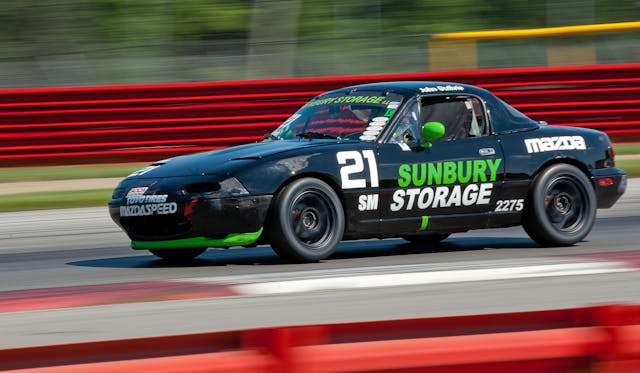
Spec Miata: Miatas have been a bit of a hot topic in vintage. Starting in 2017, the SVRA created the Spec Miata Heritage Cup for first-gen 1.6- and 1.8-liter Spec Miatas and expanded to include 1999–2005 cars in 2020. Long known as a tightly-packed class that fostered a little (or a lot) of argy bargy, Spec Miata has for two decades pitted some of the most talented amateur road racers in the country against each other in similarly-prepared cars. It’s intense—at last year’s SCCA National Championships at Indy, the top eight cars qualified within a second of one another, and the top 33 were within two seconds of the pole.
Vintage racing die-hards see Spec Miatas as too feisty and not classic enough for the more staid vintage weekends. To that, this Miata owner says pish-posh. They’ve been the backbone of an entire era of amateur racing and represent the modern version of all those British roadsters the purists love. In vintage, Miata fields are strong and yield some of the best racing, although it tends to be a little less dramatic than on a SCCA weekend.
Plus, they’re, well, Miatas—affordable, reliable, and reasonably easy to come by. You can easily find a complete Spec Miata for $10,000–$15,000 that will be more than capable for a beginner, and in the right hands can give plenty of people a run for their money. As mentioned, top-flight SM cars can fetch $40,000, but that often gets you a brand new car with a lot of spares. Consumables like brakes and tires last comparatively forever in these cars, and they’re reliable enough that if you keep it clean on track, your time working in the paddock can be limited to torquing wheels and checking pressures and fluids. It might not have the old-school look, but it’s a ticket to the show (in the SVRA, at least).
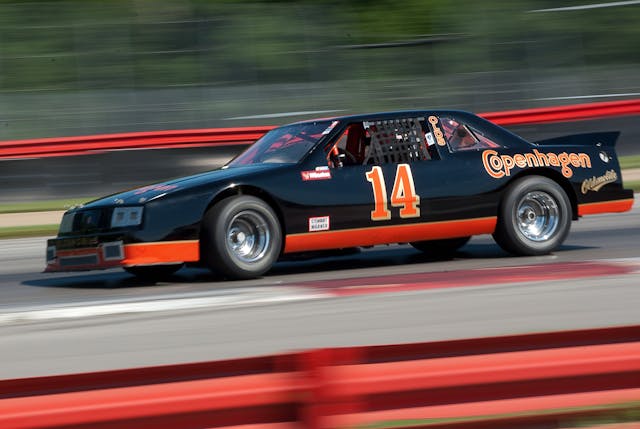
Big-bore: Who doesn’t love a throaty V-8? You have plenty of options here. Road course stock cars from the ’80s through the early 2000s often trade hands from $25,000–$50,000 depending on history, state of repair, and spares. It’s a relatively affordable entry point and parts tend to be cheap and readily available; however, all that power means you’ll go through consumables quickly, and drivetrain rebuilds can get costly. As you can see from the understeer in the above photo, these cars aren’t nearly as nimble as some of the others on the list and are typically relegated to track-specific events versus temporary courses.
Among other V-8 options, older GT1 cars and cars classed in A Sedan (Mustangs, Camaros, Firebirds, etc.) can represent excellent value. There’s a potent 500-hp 1968 GT1 Corvette on the SVRA Marketplace listed for $38,500 that has been a known commodity at Mid Ohio for decades. Cars like that are a good blend of style and power, if not quite as outright fast as younger rides. Newer, tube-frame GT1 cars (think modern Trans Am cars with composite body panels and large wings) can get north of $75,000 or even $100,000 depending on the package.
With any of these beasts, it’s important to be honest with yourself about your experience and capabilities. These are a lot of car and benefit from a seasoned driver.
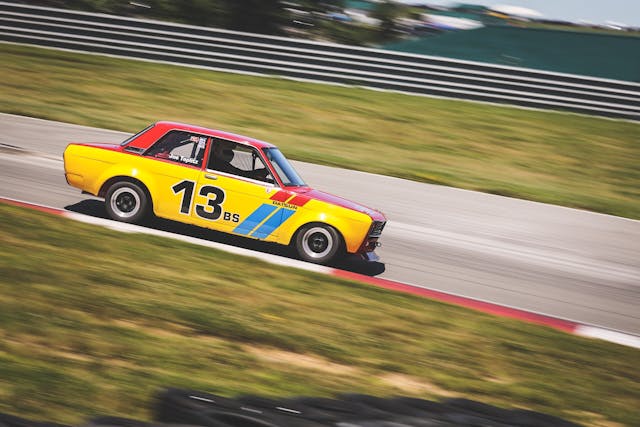
B Sedan: Here’s where small-bore heroes like the BMW 2002, Datsun 510, and Alfa Giulia come to play. Large fields (especially on the west coast) ensure you’ll have someone to race against, and the community in this class is pretty strong as well. There’s a big price swing in B Sedan: Plenty of pristine Alfa GTAs have brought more than a quarter million at sale, yet competent lesser Giulias converted to race cars trade hands for $40,000–$70,000. Cars for even less are out there, but be wary of “deals” unless you’re prepared to do a little work.
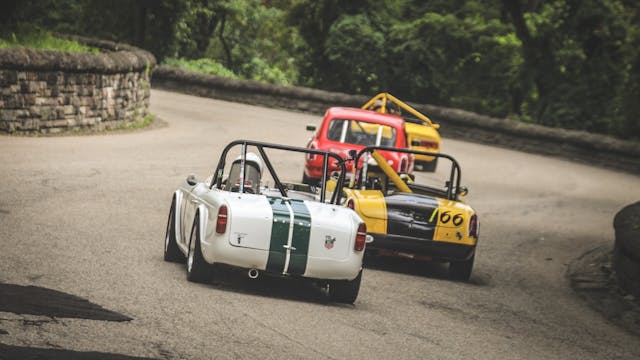
Anything British: There’s something special about choosing a little British sports car to run vintage. Yes, you’ll be subject to more time fiddling underhood and jokes about your electrical system, but MG, Triumph, Austin Healey, and others were chief protagonists in America’s budding love affair with the sports car.
Pick your brand—there are plenty of Brit racers out there that can be had for less than 20 grand. This might not get you a front-running car, but you won’t be embarrassed by it. They’re easy to work on and parts are cheap, too. As in any form of racing, things get expensive if you want to push to the front of the grid.
If you’re not first you’re … just fine.
For the vast majority of vintage racers, the front of the grid is beside the point. If you’ve wheeled in other series, that can require a major attitude adjustment: You aren’t sharing the grid with 20 other drivers who are dead set on winning. If you are one of those seeking a trophy, understand that there are others who are happy to be out there pushing their car to what might be a lower limit.
On the flip side, if this is a glorified track day for you, recognize that others may develop some red mist and keep an eye on your mirrors. Once you’re back in the paddock, the social aspect tends to take over, and you’ll have a story or two to add to the many that your car has been through over the years.
Putting the sport back in spectating
One last note: Vintage races are great to watch. Events like the Pittsburgh Vintage Grand Prix’s Schenley Park Race Weekend and the Put-In-Bay Vintage Sports Car Races attempt to bring back some of the immediacy of racing’s heyday; portions of public roads (in PVGP’s case) or airport runways, like at Put-In-Bay, are set up as temporary courses.

Particularly at the temporary circuits, don’t forget your camera. Compared to modern tracks, there are often better lines of sight, access, and more interesting backdrops to catch the cars in action—the Pittsburgh Vintage Grand Prix’s undulating course through Schenley Park is rich with chances to shoot through foliage, around old stone walls, mature trees, and of course, hay bales.

Naturally, though, most races are held at permanent circuits, and they have their own advantages. Ample runoff and fewer obstacles means speed (and courage) amp up more than on temporary courses. And these tracks are often simply bigger, meaning they can host a broader array of cars.
Regardless of event location, paddock access is typically excellent, and filled with people eager to share stories about their cars and experiences. More often than not, there are accompanying car shows for street vehicles and other gatherings like swap meets for vintage collectibles. It’s relaxed and festive— a great atmosphere for longtime enthusiasts and newbies alike. So, what are you waiting for? Get out there and have fun.
Check out the Hagerty Media homepage so you don’t miss a single story, or better yet, bookmark it.
